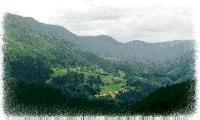
France is the most important agricultural nation of Western Europe. Its extensive areas of rich soils, especially in the Paris Basin, plus generally moderate climates and vast extents of flat to gently rolling terrain help provide an agricultural industry that has always been a mainstay of the country's economy. In addition, the unusual variety of climates, from the cool, wet plains of the north to the dry-summer warmth of the Mediterranean, makes possible a great diversity of crops and agricultural products. France lacks only a suitable climate for purely tropical crops.

France also is the only major European
nation to be generally self-sufficient in basic food production, and one of the few with
an excess of agricultural export income over import expense. The importance of agriculture
to the French economy is reflected by the 8.4 percent of the labor force employed in
farming, a relatively high figure for the industrially developed European nations. The
chief agricultural region of France is the Paris Basin, where such productive districts as
the Beauce, Picardy, and Ile-de-France form the nation's traditional breadbasket. Wheat
has always been the leading crop on the comparatively large farms here, although it is
grown throughout the lowlands. In most years France produces almost 5 percent of the
world's wheat, and it ranks fifth among the wheat-growing nations. France grows more than
twice as much wheat as does Italy, the second most important European producer, and wheat
is a major export. 
Other grains grown by French farmers include barley, which is especially important to the brewing industry, and oats and rye. These crops tend to be raised in poorer soils or in areas where the climate is less well suited for wheat. Since World War II corn has become a very popular crop in the Paris Basin and nearly everywhere else in France. Traditional types of corn have been grown in Aquitaine and the Pyrenees in southwestern France, and in the Rhone-Saone Valley, since the 16th century. However, the recent introduction of new hybrid varieties from the United States, and the greatly increased demand for animal fodder as meat consumption has risen, have made cornfields a common sight in France.
On the north ern edge of the Paris Basin, where the flatlands
of the North Sea plain lead into Picardy and Flanders, sugar beets and potatoes have been
important crops since Napoleonic times. The cool, moist regions of Normandy and Brittany
are noted for dairy products; early spring vegetables, which are highly prized in the
Paris markets; and apples.
ern edge of the Paris Basin, where the flatlands
of the North Sea plain lead into Picardy and Flanders, sugar beets and potatoes have been
important crops since Napoleonic times. The cool, moist regions of Normandy and Brittany
are noted for dairy products; early spring vegetables, which are highly prized in the
Paris markets; and apples.
After the Paris Basin, the principal French agricultural regions are in the south and southwest, particularly Aquitaine and Languedoc, and the Rhone Valley. The generally good soils and warm, dry summers of these regions make them ideal for cultivating grapes, and they are the nation's major wine producers. Europe produces about three fourths of the world's wine, with France and Italy each accounting for slightly more than 20 percent. The relatively high value of wine has led many farmers in the south to substitute grapes for other crops, resulting in overproduction and bitter competition with Italy, Spain, and other nations. Other fruits, such as peaches, plums, and apricots; and vegetables, particularly tomatoes, are also widely grown in these regions. The basis of canning and processing industries there, they are also sold fresh in city markets.
Better-quality wines,
many with famous names and high prices, are also the basis of agricultural prosperity in
such regions as Burgundy, Bordeaux, Alsace, Champagne, and the Loire Valley. These wines,
together with wheat and other crops, often create a more balanced rural economy. In the
Alps, the Pyrenees, and the Massif Central, where the soils and climate are less suited to
agriculture, many low-producing farms have been abandoned. 